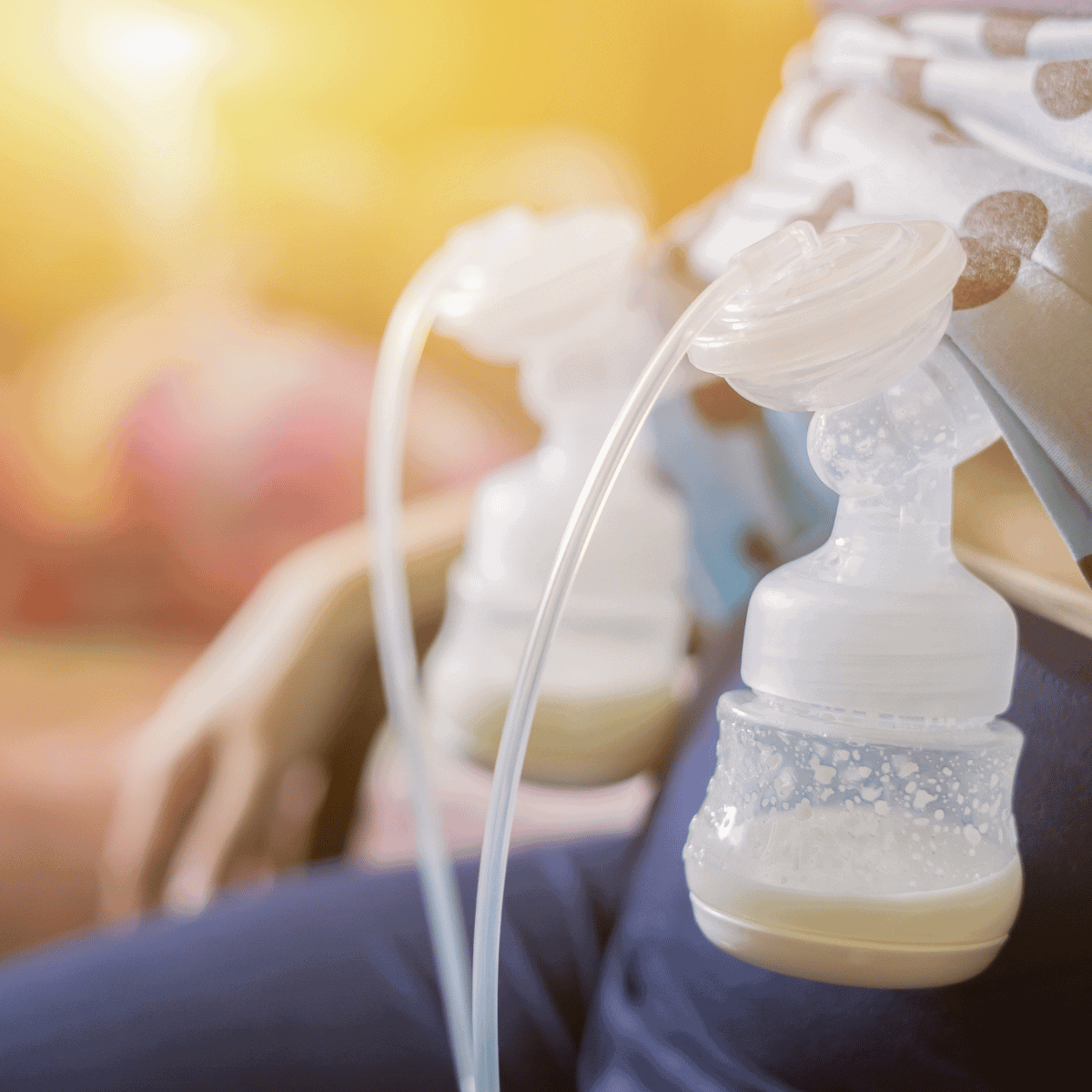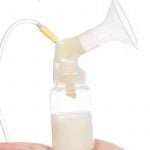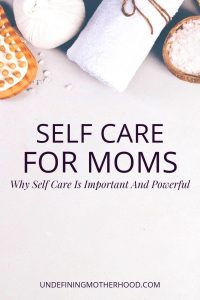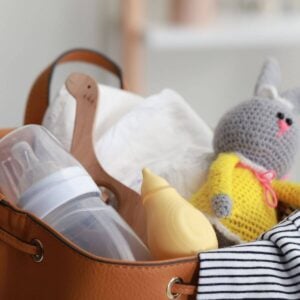I won’t lie to you: exclusive pumping can be really tough, mama. It requires a lot of time and effort to stay snuggled up to a pump instead of to a baby. However, there are a lot of benefits to exclusive pumping if you can’t (or don’t want to) breastfeed.
If you’ve found yourself here to start your exclusive pumping journey, we’ve got lots of tips for you because we’ve been there!

This site contains affiliate links, meaning that we earn a small commission for purchases made through our site. We only recommend products we personally use, love, or have thoroughly vetted.
- What You Should Know About Exclusive Pumping
- What Is Exclusive Pumping?
- Benefits of Exclusive Pumping
- Exclusive Pumping Can Be Tough Mentally
- Exclusive Pumping Tips
- 1. Set Up Your Pumping Space
- 2. Get a Good Pump
- 3. Get a Manual Pump, Too
- 4. Make Sure You Have the Right Size Flange
- 5. Get A Good Hands-Free Pumping Bra
- 6. Set Up a Pumping Schedule that Works With Your Body
- 7. Pump Straight Into Bottles or Bags that You Can Feed From
- 8. Set Up a System for Washing/Sanitizing Your Pump Parts
- 9. Be Ready to Pump On-the-Go
- 10. Share the Load, Mama!
- 11. Give Yourself Grace
- You’ve Got This, and We’ve Got YOU!
- Other Breastfeeding Articles
What You Should Know About Exclusive Pumping
- Exclusive pumping is when you don’t directly breastfeed your baby. Instead, you pump breast milk for your baby, who then takes it from a bottle or other feeding device.
- Exclusive pumping is a great way for you and your baby to get the long-term health benefits of breast milk if your child can’t nurse (or you don’t want to breast/chestfeed)!
- Pumping more often for short sessions will help you express more breast milk than if you pump longer but for fewer times throughout the day.
Why trust us?
Katy Huie Harrison, PhD, offers her personal experience with exclusive pumping (and expertise from her lactation consultant!), and Samantha Radford, PhD, CLC, our Resident Health Scientist and certified lactation consultant, has over 10 years of breastfeeding and pumping experience. Edited by Sarah Creel, PhD.
What Is Exclusive Pumping?
Exclusive pumping might sound like a fancy term if you haven’t heard of it before (I hadn’t!), but it’s actually exactly what it sounds like: instead of directly breastfeeding your baby, you pump breast milk full time.
Some parents exclusively pump just until their baby can nurse directly, and then they switch to direct breastfeeding (this was my experience). Others exclusively pump for their entire breastfeeding journey.
There are many valid reasons why parents exclusively pumping, including:
- Baby can’t latch or stay latched due to a recessed chin or other issue
- Baby has gotten used to a bottle nipple and won’t nurse anymore
- The parent has trauma, body dysmorphia, or some other reason they don’t feel comfortable with direct breastfeeding.
While exclusive pumping can be tough, it’s a beautiful way for you to take care of your baby’s health, and there is absolutely nothing wrong with feeding your child in this way.
Benefits of Exclusive Pumping
While pumping might not give off the same cuddly vibes as letting baby drink straight from the tap, it still offers some really great advantages, such as:
- Baby gets the benefits of breast milk
- You get many of the long-term health benefits of breastfeeding for you!
- Breast milk can be lifesaving for extremely low birth weight infants
- It’s easier to know how much milk you produce and how much your baby takes in
- If you’re going back to work outside the home, the transition can be easier
- It’s easier to let others feed the baby
Important Note:
If your baby can’t breastfeed and has a condition such as a malabsorption disorder, congenital heart disease, or allergies, they may benefit greatly from breast milk instead of formula (especially if they’re in the NICU).
Prescribed donor milk is often covered by insurance for these babies. Check out the Human Milk Banking of North America for a milk bank near you if you want to explore this option instead of exclusively pumping.
Exclusive Pumping Can Be Tough Mentally
I won’t lie to you: exclusive pumping can be really tough. It requires a lot of time and effort snuggled up to a pump instead of to a baby. With that said, there are a lot of benefits to exclusive pumping if you can’t (or don’t want to) breastfeed.
Many moms find themselves exclusively pumping with heavy hearts, having desperately wanted to breastfeed. I exclusively pumped for the first 3 months of Jack’s life because he had micrognathism, or newborn recessed chin, which made it impossible for him to latch.
Many parents who can’t breastfeed exclusively pump for the health benefits of breast milk, and that’s pretty amazing. Here’s the thing, though…some of us love it, and some of us loathe it. I’m here to help you do it successfully if that’s your choice, but with one very important caveat:
Exclusive pumping is not for everyone. If you can’t stand it, and the struggle is a detriment to your mental health, there is nothing wrong with choosing to wean from it when it feels right to you. You do what you need to do for yourself, mama.
But if you choose to go down this exclusive pumping road, here are all the tips I wish I’d known!
Exclusive Pumping Tips
Even though it’s difficult, there are things you can do to make exclusively pumping work better for you.
1. Set Up Your Pumping Space
You’re going to spend a lot of time tied to your pump, so make it as enjoyable as possible! Set up a pumping station with:
- A cozy glider
- Breastfeeding Snacks
- A water bottle (staying hydrated is essential)
- A blanket
- Hair ties
- The remote control (old sitcoms are the perfect length for a longer pumping session!)
- A nearby electrical outlet and a phone charger
- Your earbuds or headphones
- A kindle or a good book
- Extra pump parts
- Bottles and/or milk storage bags
And whatever else you’d like to have near you as you pump!
If you’ll be pumping at work, you’ll want to talk to your supervisor about how they’ll provide a pumping area and break time for you. In the United States, your employer is legally required to allow you time and space to pump (with very few exceptions).
2. Get a Good Pump
If you’re exclusively pumping, it’s essential to have a good, double electric pump, so that you’re double pumping. That means you’re expelling breast milk from both breasts at the same time.
Struggling to select a breast pump from the massive number of options? Check out our article on how to choose a breast pump for a thorough review of a ton of breast pumps!
Many women say their bodies don’t respond to pumps, and for some women, this may be true. But in many cases, breast pumps don’t work because mama is using the wrong pump for her body.
Here’s some great pumps to try:
1. Spectra S1
The Spectra S1 is my favorite option for a number of reasons.
Pros: Hospital grade (better for milk production), rechargeable battery (doesn’t have to be plugged in and is thus super portable), closed system (no need to clean narrow tubing), tons of settings (so you can find what works for your body).
Cons: Flanges can be very awkward to get into a pumping bra.
*Note: The Spectra S2 is slightly less expensive and also an amazing option, but it requires being plugged into the wall and thus loses portability.
2. Medela Symphony
This is the pump I used through most of my pumping journey because you can rent it from the hospital, making it way more affordable than paying for the full thing!
Pros: Hospital grade breast pump, proven to produce 18% more milk than other double electric pumps, the quietest and most comfortable pump I used, and holy milk supply!
Cons: Cost! I can’t imagine having paid out of pocket for this pump. Also, it’s large and heavy, so not good for travel or portability for working moms.
Pro tip: Avoid the Medela Pump In Style. All my lactation consultant friends bemoan this pump, which just happens to be the most popular breast pump. They swear that it’s TERRIBLE for milk production. I tried it, and my breast milk oversupply rapidly turned into an undersupply. Not good.
3. Get a Manual Pump, Too
I know, I know. I can hear you now.
“But you said I needed a double electric pump. I have this fancy system. Why would I want a cheap little manual one?”
Here’s why. Because your power will go out. Your pump will break. You’ll find yourself desperate to pump but without time to hook up and do it. You’ll need to pump while you’re in a restaurant.
Trust me. Something will happen where that manual pump will be your best friend, probably multiple times. And if you never ever use it, well, you’ve spent under thirty bucks to be over prepared–the stakes aren’t too high!
Pros: Easy to carry around, works even if the power goes out.
Cons: Doesn’t work as well as an electric pump, can only express one side at a time.
- Make Sure You Have the Right Size Flange
4. Make Sure You Have the Right Size Flange
Did you know that the flange (the funnel-shaped part your boob goes in) your pump comes with is likely too small? Proper flange size is essential for both comfort and efficient milk expression.
This podcast episode that our Resident Scientist, Samantha, recorded with Melissa Portunato, IBCLC, explains everything you need to know about flange sizes.
5. Get A Good Hands-Free Pumping Bra
Pumping is hard enough without having to hold the bottles up to your boobs for 20 minutes at a time. Instead, free up those hands with a hands-free pumping bra (like the Sublime Hands-Free Pumping and Nursing Bra from Kindred Bravely).
This way, you can hold the baby, use your phone, or even eat while you pump! Score.
6. Set Up a Pumping Schedule that Works With Your Body
When you’re exclusively pumping, a schedule is really helpful because it helps you build supply and tells your body when to produce milk.
Ultimately, you’re mimicking what would happen if you were breastfeeding your baby directly–you would (ideally) produce milk at the times whenever they would normally nurse.
Here are some general guidelines for pumping on a schedule:
Newborn
If your baby was just born in the past few days and you are still making colostrum, hand expression will give you much better results than a pump. You may only express a few spoonfuls of colostrum at a time, and that’s totally normal!
Try to hand express within the first hour of birth (or at least within the first 2 hours) to prime your prolactin receptors.
This little action makes a big difference in your milk supply for the rest of your breastfeeding journey.
0-3 months
A good rule of thumb is 10-12 times in 24 hours (12-15 minute pumping sessions), including a middle-of-the-night pump around 3am. This middle-of-the-night session is often the hardest, but because prolactin levels are highest at night, it’s essential for keeping supply up (sorry!).
When I stopped doing it, my supply dropped. If you struggle with low production as a new mom, many people suggest pumping 12 times a day to get your production up! More frequent, shorter sessions increase milk volume better than fewer long sessions.
3 months
When baby is 3 months old, you can reduce your pumping sessions to 5-6 times in 24 hours (15-20 minute sessions). If you’re producing well, you can drop the middle-of-the-night pump. Unfortunately, you’ll have to be ready to start it back up if your supply dips.
6 months
At 6 months, you can pump 4 times per day (20 minute sessions). You’re likely starting your baby on solids at this point, so their milk intake will start to decrease. But they still rely mostly on human milk for their nutritional needs at this time, so let this fact guide your pumping schedule.
8+ months
By 8 months, you can start to pump as needed. You’ll know your body by this time, and any schedule I give you will make you scoff because you know better. So listen to your body. Also, you’re a total badass for exclusively pumping for so long!
7. Pump Straight Into Bottles or Bags that You Can Feed From
There are systems (like the Kiinde breastmilk feeding system) that have milk storage bags with an attachment to hook them straight to ANY breast pump.
You pump straight into the bags, store the bags, pop them into the included warmer, add a bottle nipple, and feed baby straight from the bottle. Amazing.
Date the bags and use them oldest-newest.
This system saved me 2+ hours a day on dishes. I’m not exaggerating. The one major downside is that the pouches aren’t reusable, but they are recyclable. I asked for them as gifts and reminded myself of the money I wasn’t spending on formula.
Definitely add this to your list of baby registry must haves!
8. Set Up a System for Washing/Sanitizing Your Pump Parts
You are going to have so many more dishes to do than bottle-feeding or exclusively breastfeeding moms. You’ll want to wash your parts with Dapple soap because it’s the BEST at breaking down the proteins of human milk that like to stick to everything.
Still, there’s so much to keep clean that you’ll want to be able to pop your pump parts into the sterilizer once you’ve done that. We LOVE the Baby Brezza sterilizer.
Note: If your baby is healthy, the CDC says you can probably drop sanitizing after 2 months if you continue to clean everything thoroughly.
9. Be Ready to Pump On-the-Go
If you’re back at work, you can save time by pumping during your commute. Use your hands-free bra and a pump with a battery pack (or just plug your pump into your car) and go! Just make sure you have ice packs, bags, and a cooler to store that liquid gold.
10. Share the Load, Mama!
The thing about exclusive pumping is that it can start to feel really restricting, time-wise…because (and there’s no other way to say this) it is. That’s why we recommend the pumping bra and/or pumping on your way home from work (if you’re going back to paid labor).
Since you’ll be spending 2-3 hours per day not able to do anything other than pump, you’re going to need to call in your team. Please don’t feel like you have to do it all when you’re pumping around the clock in those early moments–or ever.
Here’s a few suggestions for how to let your people help you:
- Keep your partner or support people involved. After all, if you’re spending hours pumping, they can wash and sanitize pump and bottle parts!
- Have friends or family rotate coming over to hold the baby while you pump. And if they offer to clean bottle parts, don’t stop them!
- Hire a neighborhood teen or college student to help if that’s available to you. For me, a college-age neighbor would come over, clean my bottle and pump parts, empty my diaper pails, and do Jack’s laundry so that I could put the hands-free time into pumping, not cleaning.
11. Give Yourself Grace
This might be a hard time for you, and I totally get that. It certainly was for me, especially at first. If you’re anything like me, you may harbor guild for things like:
- Not being able to breastfeed
- Not producing “enough”
- Hating pumping
- Being so freaking tired
- Resenting the work that goes into your baby
- Resenting your partner’s useless nipples (unless you’re partnered with another woman who has chosen to induce lactation)
- Letting the baby cry while you pump long enough to avoid engorgement and mastitis
Remember, even if it doesn’t feel like it, you are a freaking rock star who IS producing milk for your baby. Remind yourself that this really difficult phase won’t last forever, and one day it will be better. Because it will. Taking it one day at a time is the only way to go.
You’ve Got This, and We’ve Got YOU!
While exclusive pumping can be a tough journey, it has lots of benefits for both your baby and you. And if you’re not, please know that that’s okay! YOU are the expert on how to feed your baby; we are just here to provide you with all the information you need to make informed choices.
If you do start this journey, please make sure that you get the help you need and find a nice pump; it really makes all the difference.
You’ve got this, Mama! If this is the route for you and your baby, we are proud of you! Let us know if you have any questions or comments about exclusive pumping.
Other Breastfeeding Articles
- How to increase breastmilk supply
- How to Correct Breast milk oversupply
- The BEST Nursing Pajamas
- How to Choose a Breast Pump
- Dairy Free Breastfeeding
- Healthy Breastfeeding Snacks
- How to Set Up A Breastfeeding Station
- Our Favorite Breastfeeding Supplies and Freebies










